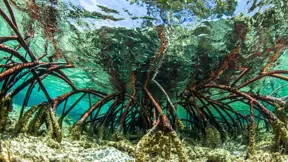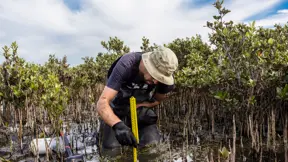
Kingfisher Wetlands: a living laboratory for blue carbon research
A study in Singapore on the potential for carbon capture in urban mangrove wetlands
Gardens by the Bay is an iconic horticultural attraction set in the heart of Singapore’s downtown. A horticultural treasure trove, it is home to a diverse collection of over 1.5 million plants hailing from almost every continent. In 2021, Gardens by the Bay developed the area now known as Kingfisher Wetlands into a central urban wetland with enhanced microhabitats to encourage biodiversity, in turn enriching the visitor experience with a charming landscape and better connectivity to the rest of the Gardens. Beyond aesthetics, the project is also inspiring research into the question: can urban mangrove wetlands help us in our fight against climate change?
Challenge
At Kingfisher Wetlands, beautiful water cascades and streamlets are offering microhabitats for biodiversity to flourish. From the Wildlife Lookout, nature enthusiasts are sighting migratory birds and other animals bustling in the surroundings. Rare mangrove species are putting down roots in their new home while providing a host of ecosystem services. This freshwater wetland is a nature sanctuary right in the heart of the city.
Previously, the Lotus Pond in the area was isolated from the rest of the lake system in the Gardens, which included the nearby Kingfisher Lake. Gardens by the Bay wanted to encourage more visitor traffic as the site was physically and visually isolated from the surrounding landscape. The challenge was how to make the site more inviting for visitors while also serving the higher purpose of supporting national sustainability efforts.
Initially, the intention was to improve the aesthetics while enhancing habitats for biodiversity, since it was already a popular bird-watching spot. At the same time, Gardens by the Bay wanted to improve water circulation and aeration in the water bodies for biodiversity to thrive. Gardens by the Bay, in consultation with DHI scientists, put forward the idea of developing part of the area into an urban mangrove wetland. This would be the perfect opportunity for Gardens by the Bay to not only enhance habitats and bring people closer to nature but also testbed climate solutions.
Client:
Location:
Singapore
Related SDG(s):
SDG 13: Take urgent action to combat climate change and its impacts
Solution
Mangroves provide valuable ecosystem services – from serving as habitats as well as spawning and nursery grounds for marine species, to regulating floods, storms and erosions, to offering recreational and other cultural experiences for society. They can also help to mitigate climate change impact and help countries meet their targets for emissions reductions by absorbing blue carbon, i.e., carbon that is removed from the atmosphere by ocean systems. To enhance Kingfisher Wetlands and leverage this sustainability-themed attraction to foster community engagement, Gardens by the Bay implemented several initiatives. DHI’s scientists contributed to these efforts:
Planting of native mangroves and mangrove associates
The potential for blue carbon storage in mangroves is higher than in forests because mangrove root systems encourage sedimentation resulting in continued burial over time. In addition, marine sediments are frequently covered by water. Together, the continued sedimentation and oxygen-poor sediment environment cause a slow breakdown of the biotic materials, resulting in significant carbon storage.
Over 200 native mangroves and mangrove associates were planted in the Kingfisher Wetlands. DHI provided guidance on the selection of mangrove species and monitored their health and growth. These include native and critically endangered mangrove species such as the Firefly Mangrove (Sonneratia caseolaris) and Upriver Orange Mangrove (Bruguiera sexangula). Over the first monitoring period of nine months (from January to September 2022), the mangroves have remained healthy with good survival.
Results
Kingfisher Wetlands is an outdoor attraction in the Gardens that contributes to sustainability. With the urban mangrove wetlands and newly-created water cascades and streamlets, there are now more spaces for biodiversity to flourish. Furthermore, research into blue carbon science may guide the development of urban mangroves and help combat climate change and its impacts, in line with Sustainable Development Goal 13.
- Paves way to explore the potential of manmade wetlands for long-term carbon storage
- Offers insights into scaling the solution for use in other parts of Singapore or other cities
- Brings people closer to nature and inspires learnings on blue carbon, biodiversity and sustainability
‘Annually, mangroves have been found to capture 3-5 times more carbon per unit area than tropical forests, playing an important role in the mitigation of climate change. By planting mangroves, Kingfisher Wetlands serves as a living laboratory which gives us the opportunity to study their potential to be used as nature-based solutions in other urban areas.’
Mr Addison Goh, Senior Director (Sustainability Office)
Gardens by the Bay
About our client
An integral part of Singapore’s ‘City in Nature’ vision, Gardens by the Bay is a national garden and premier horticultural attraction that showcases the best of garden and floral artistry for all to enjoy. Spanning 101 hectares in the heart of Singapore’s downtown Marina Bay, it comprises three waterfront gardens – Bay South, Bay East and Bay Central. Bay South, the largest at 54 hectares, officially opened on 29 June 2012.
You may also like
How can we help?
With our global network of offices, we make sure you get the right answers to your local needs. Tell us about your water challenges and we will get back to you.


